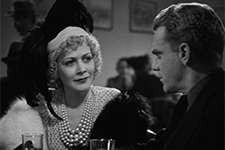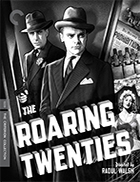The Roaring Twenties (4K UHD)
|  In the early 1930s, Hollywood had a gangster problem. Films like Little Caesar (1931), The Public Enemy (1931), and, most notoriously, Scarface (1933) were increasingly popular hits at the box office and were also increasingly graphic in their depictions of gun violence and criminality. Of course, they (more or less) adhered to the letter of the Production Code by ensuring that their gangster (anti)heroes died for their transgressions in the final reel, but audiences still found them engaging, sympathetic, and even enthralling, just as they did with real-life bootleggers like Al Capone, whose Prohibition-defying supply of booze to thirsty Americans turned them into populist heroes. The industry tried to rein in what it had unleashed by adding a lengthy addendum to the Production Code—“Special Regulations on Crime in Motion Pictures”—which added twelve additional guidelines in 1935, but it was too little too late. While the addendum had the temporary effect of cutting down on the number of crime films made, it never stamped them out completely, and by the end of the 1930s there was a new cycle of gangster pictures putting holes in silver screens all across America. These were often made with a twist to separate them from the early-’30s “classic” gangster films even as they often starred familiar faces like James Cagney and Edward G. Robinson. So, for example, Michael Curtiz’s Angels With Dirty Faces (1938) followed boyhood friends from a squalid tenement, one of whom grows up to be a gangster and one of whom grows up to be a priest. In a different vein, Lloyd Bacon took the genre in the direction of dark comedy in A Slight Case of Murder (1938), where, according to the critic in Variety, “the underworld is turned inside out and scenes which once chilled the spectators with horror are the occasion here for hearty laughter.” And this brings us to Raoul Walsh’s The Roaring Twenties, which is perhaps the most ambitious and successful of these new gangster films. The twist here is the presence of nostalgia, which is reflected in the film’s grabby title, one that was so effective it literally created a new moniker for the decade previously known as The Jazz Age. Walsh cast a host of familiar faces from previous gangster films, most notably James Cagney and Humphrey Bogart (in the last of their three collaborations), to anchor a story that feels like it was assembled from a gangster greatest hits machine. The screenplay by Jerry Wald and Richard Macaulay (who co-wrote Walsh’s They Drive by Night the following year) and Robert Rossen (The Hustler) from a short story titled “The World Moves On” by journalist-turned-screenwriter Mark Hellinger has all the hallmarks of the genre, but is constructed in such a way that the seams don’t show. The film just flows. Cagney stars as Eddie Bartlett, a good guy who finishes his service in World War I only to find that there are few if any opportunities for him in the country he left to fight. The auto garage where he was previously employed has filled his position despite promises to hold it open for him, and he ends up driving a cab along with his good-natured, but dim-witted buddy Danny Green (Frank McHugh). Things take a turn when he tasked with unknowingly delivering booze to Panama Smith (Gladys George), a bootlegging moll who appears at first to throw him under the bus, but soon returns to retrieve him from prison and give him an opportunity to get in on the illegal alcohol trade. As it turns out, Eddie is a natural bootlegger, and soon he is running a major operation that is fronted by Panama’s swank nightclub and a cab business. He partners with George Hally (Humphrey Bogart), who he met in the trenches in Europe. George is a tough operator in the way only Bogart could be, back before his meanness and cynicism was cut with Casablanca-style romanticism, and you can’t help but sense that he is a ticking bomb. Eddie is also distracted by Jean Sherman (Prischilla Lane), a young woman who wrote him pen-pal letters during the war. He gives her the opportunity to sing in Panama’s club with the idea that someday they will get married, but her eyes are drawn to Lloyd Hart (Jeffrey Lynn), a lawyer Eddie met during the war. Unlike the charming psychopaths of The Public Enemy and Scarface, Eddie is essentially a good guy forced by dire circumstances into illicit activities. He never turns fully villainous (that is Bogart’s job), and Cagney consistently maintains Eddie’s humanity in what has to be counted as one of his greatest, most subtle performances (he is always, at heart, a wounded soul). He has his big moments of exhilaration and anger, and at a few points we fear he will lose it entirely and do something truly cruel. But, he always pulls his punches at the last moment, even when he is deeply hurt, because that decent guy we met at the beginning of the film is never fully snuffed out. Eddie’s fall is decidedly more precipitous and emotionally torturous than his gangster forebears, which makes the film’s final reels into a sad portrait of a once thriving man reduced to little more than ashes, albeit ashes from which he will rise up one more time, even if it is ultimately in vain. Often referred to as a “filmmaker’s filmmaker,” director Raoul Walsh was mentored by D.W. Griffith, for whom he played Lincoln assassin John Wilkes Boothe in The Birth of a Nation (1915). However, his place was behind the camera, not in front of it, where he churned out dozens of tough thrillers and dramas and westerns from the 1910s through the 1960s (in some years he turned out four or five features). He knew movement and action and pace, and his films are renowned for their gripping momentum and effective, but never showy aesthetics. The Roaring Twenties marked the beginning of one of the best stretches of his career, as he shifted from Paramount (where he spent five years making not particularly great films) to Warner Bros., where he helmed some of his best known works, including High Sierra (1941), They Died With Their Boots On (1941), and White Heat (1949), which brought Cagney back to the gangster genre one last time. Describing Walsh in The American Cinema, Andrew Sarris noted, “Walsh … always possessed the necessary technical skills and artistic instincts to bring off the most ambitious physical spectacles. His best films are genuinely exciting, though neither profound nor pretentious.” One couldn’t find a much better description of The Roaring Twenties.
Copyright © 2024 James Kendrick Thoughts? E-mail James Kendrick All images copyright © The Criterion Collection | |||||||||||||||||||||||||||||
Overall Rating: 


 (3.5)
(3.5)


